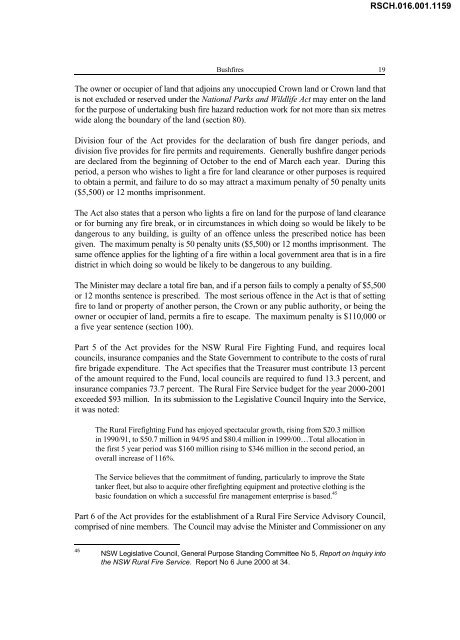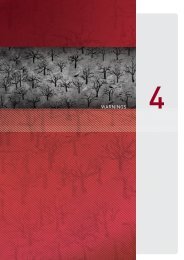RSCH.016.001.1136 - 2009 Victorian Bushfires Royal Commission
RSCH.016.001.1136 - 2009 Victorian Bushfires Royal Commission
RSCH.016.001.1136 - 2009 Victorian Bushfires Royal Commission
Create successful ePaper yourself
Turn your PDF publications into a flip-book with our unique Google optimized e-Paper software.
RSCH.016.001.1159<br />
<strong>Bushfires</strong> 19<br />
The owner or occupier of land that adjoins any unoccupied Crown land or Crown land that<br />
is not excluded or reserved under the National Parks and Wildlife Act may enter on the land<br />
for the purpose of undertaking bush fire hazard reduction work for not more than six metres<br />
wide along the boundary of the land (section 80).<br />
Division four of the Act provides for the declaration of bush fire danger periods, and<br />
division five provides for fire permits and requirements. Generally bushfire danger periods<br />
are declared from the beginning of October to the end of March each year. During this<br />
period, a person who wishes to light a fire for land clearance or other purposes is required<br />
to obtain a permit, and failure to do so may attract a maximum penalty of 50 penalty units<br />
($5,500) or 12 months imprisonment.<br />
The Act also states that a person who lights a fire on land for the purpose of land clearance<br />
or for burning any fire break, or in circumstances in which doing so would be likely to be<br />
dangerous to any building, is guilty of an offence unless the prescribed notice has been<br />
given. The maximum penalty is 50 penalty units ($5,500) or 12 months imprisonment. The<br />
same offence applies for the lighting of a fire within a local government area that is in a fire<br />
district in which doing so would be likely to be dangerous to any building.<br />
The Minister may declare a total fire ban, and if a person fails to comply a penalty of $5,500<br />
or 12 months sentence is prescribed. The most serious offence in the Act is that of setting<br />
fire to land or property of another person, the Crown or any public authority, or being the<br />
owner or occupier of land, permits a fire to escape. The maximum penalty is $110,000 or<br />
a five year sentence (section 100).<br />
Part 5 of the Act provides for the NSW Rural Fire Fighting Fund, and requires local<br />
councils, insurance companies and the State Government to contribute to the costs of rural<br />
fire brigade expenditure. The Act specifies that the Treasurer must contribute 13 percent<br />
of the amount required to the Fund, local councils are required to fund 13.3 percent, and<br />
insurance companies 73.7 percent. The Rural Fire Service budget for the year 2000-2001<br />
exceeded $93 million. In its submission to the Legislative Council Inquiry into the Service,<br />
it was noted:<br />
The Rural Firefighting Fund has enjoyed spectacular growth, rising from $20.3 million<br />
in 1990/91, to $50.7 million in 94/95 and $80.4 million in 1999/00…Total allocation in<br />
the first 5 year period was $160 million rising to $346 million in the second period, an<br />
overall increase of 116%.<br />
The Service believes that the commitment of funding, particularly to improve the State<br />
tanker fleet, but also to acquire other firefighting equipment and protective clothing is the<br />
basic foundation on which a successful fire management enterprise is based. 45<br />
Part 6 of the Act provides for the establishment of a Rural Fire Service Advisory Council,<br />
comprised of nine members. The Council may advise the Minister and <strong>Commission</strong>er on any<br />
45<br />
NSW Legislative Council, General Purpose Standing Committee No 5, Report on Inquiry into<br />
the NSW Rural Fire Service. Report No 6 June 2000 at 34.
















